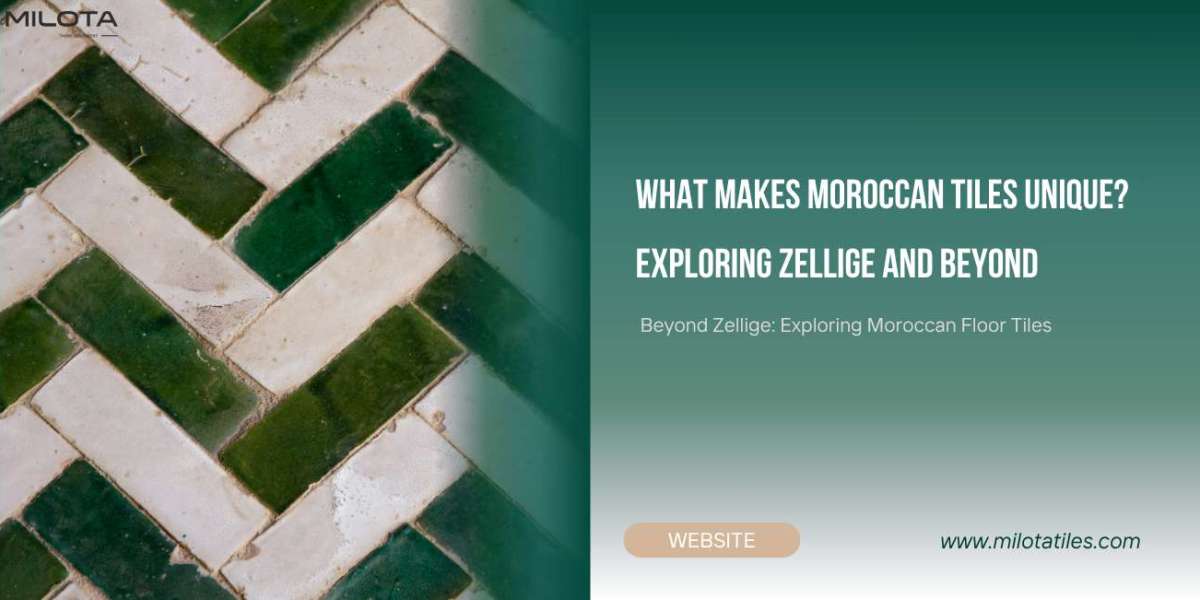For centuries, Moroccan tiles have fascinated the world with their vibrant colors, intricate patterns, and handcrafted quality. These tiles are more than just beautiful surfaces; they are artistic reflections of Moroccan culture, history, and craftsmanship. From the dazzling allure of Moroccan zellige tiles to the practical beauty of Moroccan floor tiles, each piece tells a story that spans generations.
In this article, we’ll explore what makes Moroccan tiles truly unique and why they remain a favorite among interior designers, architects, and homeowners alike.
1. The Artistic Heritage Behind Moroccan Tiles
Moroccan tile-making is a centuries-old tradition, deeply rooted in the culture and artistic identity of North Africa. Drawing from Arab, Berber, Moorish, and Mediterranean influences, Moroccan tiles incorporate geometric precision, floral motifs, and calligraphic elements that reflect Islamic art principles.
Artisans in cities like Fez and Marrakech still follow age-old techniques, crafting each tile by hand with natural clay, traditional glazes, and tools passed down through generations. These methods give Moroccan tiles their authenticity and artistic soul.
2. The Magic of Moroccan Zellige Tiles
Among the most iconic types of Moroccan tiles is zellige (pronounced zel-ij), a handmade, glazed terracotta tile originating in Fez. Zellige is considered the crown jewel of Moroccan tilework and is known for its:
Hand-cut irregular shapes
Shiny, translucent glazes
Slight imperfections that add depth and character
Reflective surfaces that play with natural light
Unlike mass-produced tiles, Moroccan zellige tiles are intentionally non-uniform. Each tile is hand-chiseled and hand-glazed, creating variations in color tone, thickness, and texture. When assembled into a mosaic, they form mesmerizing patterns with a dynamic, shimmering finish.
Zellige tiles are perfect for walls, fireplaces, water features, and backsplashes where their reflective quality and texture can truly shine.
3. Beyond Zellige: Types of Moroccan Tiles
While zellige tiles are the most renowned, Moroccan tilework encompasses a wider range of styles, each with its own applications and aesthetics:
✅ Moroccan Floor Tiles
Moroccan floor tiles are typically made from durable ceramic or cement, designed to withstand foot traffic while preserving the traditional Moroccan aesthetic. These tiles feature:
Bold geometric patterns
Earthy, matte finishes
Durability and slip-resistance
They’re perfect for entryways, kitchens, bathrooms, patios, and even stair risers. Their visual impact is both timeless and dramatic, making floors more than just a surface—they become a statement.
✅ Cement Moroccan Tiles
These tiles aren’t zellige but still reflect the Moroccan design language. Cement tiles often come in square or hexagonal shapes with decorative patterns. They're handmade using pigmented cement and hydraulic pressure, offering a robust yet artistic option for floors.
4. Unique Design Features That Set Moroccan Tiles Apart
So, what really makes Moroccan tiles different from any other tile category?
✨ Handcrafted Imperfection
No two Moroccan tiles are exactly the same. Variations in glaze, shape, and thickness create a natural, organic look. These imperfections are not flaws—they’re part of the tile’s soul.
? Vibrant, Cultural Colors
Moroccan tiles are known for their rich, earthy tones—cobalt blue, emerald green, terracotta, mustard yellow, and more. These colors are achieved using traditional glaze recipes based on natural minerals.
? Geometric & Arabesque Patterns
Tiles often feature traditional motifs such as stars, interlocking lines, and arabesques that repeat seamlessly. These designs are not only decorative but also rooted in cultural symbolism.
? Customizable Mosaic Layouts
Zellige tiles are often arranged into custom mosaics called bejmats or mashrabiyas, allowing endless creative combinations.
5. Where to Use Moroccan Tiles in Your Home
Thanks to their versatility, Moroccan tiles can be used in a variety of spaces:
Kitchens: Zellige backsplashes add instant character.
Bathrooms: Moroccan floor tiles bring warmth and texture to otherwise sterile spaces.
Fireplaces: Make your hearth a centerpiece with colorful tilework.
Outdoor patios: Moroccan tiles thrive in sunny courtyards and terraces.
Entryways & hallways: Set a grand first impression with a bold patterned floor.
By mixing modern materials with traditional Moroccan tile styles, you can create a space that’s both elegant and rooted in global design history.
6. Moroccan Tiles in Modern Design
You don’t need a Moroccan-themed home to use these tiles. Today’s designers blend Moroccan zellige tiles into minimalist, Scandinavian, and even industrial interiors.
A white zellige backsplash, for example, looks stunning in a modern kitchen thanks to its light-catching surface and irregular charm. Cement Moroccan floor tiles in geometric black-and-white designs add depth to neutral-toned rooms.
Their timelessness allows them to transcend trends while still feeling fresh and relevant.
7. Tips for Buying and Installing Moroccan Tiles
If you're planning to purchase Moroccan tiles, here are a few helpful tips:
Order Samples First: The handmade nature of Moroccan tiles means color and texture can vary. Samples help ensure you're happy with the look.
Plan for Variability: Order 10–15% more tiles than you need to account for breakage, cutting, and visual matching.
Hire Skilled Installers: Installing Moroccan tiles—especially zellige—requires precision and experience. Look for a tile professional familiar with artisanal materials.
Seal Cement Tiles: If using cement Moroccan floor tiles, seal them properly to prevent staining and water absorption.
For authentic, premium-quality Moroccan tiles, trust trusted sources like Milota Tiles that specialize in artisan products sourced directly from Morocco.
8. Sustainability and Ethical Craftsmanship
Moroccan tile production is often small-batch and eco-friendly. Zellige tiles are made from natural clay and mineral glazes, using low-impact kilns. Supporting these products means supporting local artisans and sustainable, slow craft traditions.
Buying from reputable sellers also ensures that artisans are paid fairly and their skills are preserved for future generations.
Final Thoughts
From their rich cultural origins to their stunning aesthetic and practical value, Moroccan tiles are truly unique. Whether you’re drawn to the glossy charm of Moroccan zellige tiles or the durability and artistry of Moroccan floor tiles, one thing is clear: these tiles bring beauty, history, and craftsmanship into every corner they touch.
By choosing Moroccan tiles, you’re not just decorating your home—you’re weaving a piece of global heritage into your living space.



